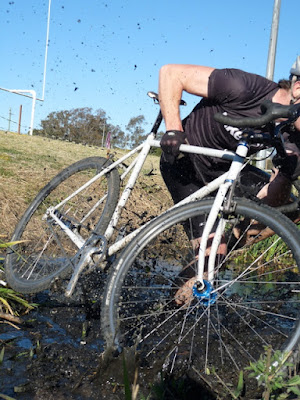Panir (or Paneer) is an Indian cheese with a mild flavour that can be eaten raw or used to cook with. It's also really easy to make and you don't need any special equipment or ingredients, so if you've ever fancied making your own cheese it's a good place to start. I'm taking the recipe from Ricki Carrol's 'Home Cheese Making' - an excellent book for budding cheese makers - but there are many similar recipes on line.
The only equipment that you need to make Paneer is
- Saucepan big enough to hold 3L of milk
- Slotted spoon
- Large knife
- Cheesecloth or muslin (available from supermarkets)
- Colander
- String or shoe-lace
- A kettle (to boil water for sterilisation)
and the ingredients are equally simple
- 3L milk (full fat or semi skimmed)
- Around a cup of lemon juice (ie 3 or 4 fresh lemons)
First use the boiling water to make sure that everything is clean & sterile. I'm doing 2 3L batches here, hence the 2 saucepans
Next comes the time consuming bit - you need to gently heat the milk up to a rolling boil. If you heat it too quickly or don't stir it regularly you'll burn the milk so you'll need something else to keep you amused. Handy hint - if you take the milk out of the fridge up to 12 hours before you plan to make the cheese it will get closer to room temperature, which saves a bit of cooking time.
While you're waiting juice your lemons
On our crappy rental stove it took around 90 minutes to get the milk up to a gentle rolling boil. Be careful when you get close to the boiling point - keep an eye on the milk and keep stirring it. If it bubbles over it can be very messy.
Reduce the heat to low and pour the lemon juice into the milk before the foam subsides. Them remove from the heat and stir gently until you get chunky bits (the curds) forming. The remaining liquid (the whey) should be clear - in the picture below it's a bit milky so if you see this put the pan back on a low heat and gently stir until the whey clears.
This is better - nice clear whey. And don't worry, it's supposed to be yellow.
Once you see this take the pan of the heat and leave it to sit for 10 minutes or so. Whilst you're doing this line the colander with the cheesecloth and sit this over a pan.
When the curds have settled below the whey, ladle the curds into the colander. Or you can carefully pour directly into the colander from the saucepan. The curds should look like cream cheese or popcorn. The saucepan underneath is to catch the whey as you want to keep that too.
Wrap the curds in the cheesecloth and rinse under cold water for 5 to 10 seconds. Also gently twist the cheesecloth to squeeze out a little more whey.
Then just hang the bag somewhere where it can gently drain for 2-3 hrs
After that, unwrap the cheese and it's good to go
You can slice it and eat it straight away, or you can store it for a couple of weeks and let the flavours mature a bit. It doesn't melt so you can also cook with it - it's excellent in curries and stews.
The whey can be used as a liquid substitute for bread making, for stock, to boil pasta in or (according to the book) "it makes a delicious summer drink when served with ice and crushed mint leaves". I haven't been game to try that one yet!
It's as simple as that. You can also work the cheese a little more after it's drained and add herbs & spices to make a flat pattie you can fry up. This is called a chenna, and if you're interested I'll add another post later showing how to do that.
Go on - give it a go on the next rainy day!



























































